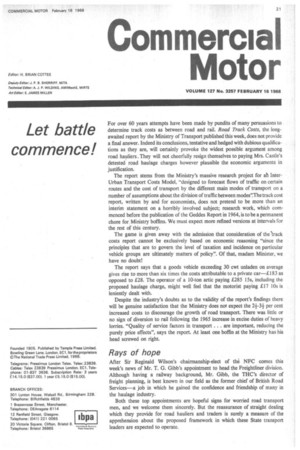Let battle commence!
Page 23

If you've noticed an error in this article please click here to report it so we can fix it.
For over 60 years attempts have been made by pundits of many persuasions to determine track costs as between road and rail. Road Track Costs, the longawaited report by the Ministry of Transport published this week, does not provide a final answer. Indeed its conclusions, tentative and hedged with dubious qualifications as they are, will certainly provoke the widest possible argument among road hauliers. They wilt not cheerfully resign themselves to paying Mrs. Castle's detested road haulage charges however plausible the economic arguments in justification.
The report stems from the Ministry's massive research project for ah InterUrban Transport Costs Model. "designed to forecast flows of traffic on certain routes and the cost of transport by the different main modes of transport on a number of assumptions about the division of traffic between modee!The track cost report, written by and for economists, does not pretend to be more than an interim statement on a horribly involved subject; research work, which commenced before the publication of the Geddes Report in 1964, is to be a permanent chore for Ministry boffins. We must expect more refined versions at intervals for the rest of this century.
The game is given away with the admission that consideration of the Irack costs report cannot be exclusively based on economic reasoning "since the principles that are to govern the level of taxation and incidence on particular vehicle groups are ultimately matters of policy". Of that, madam Minister, we have no doubt!
The report says that a goods vehicle exceeding 30 cwt unladen on average gives rise to more than six times the costs attributable to a private car—£183 as opposed to £28. The operator of a 10-ton artic paying £285 15s, including the proposed haulage charge, might well feel that the motorist paying £17 lOs is leniently dealt with.
Despite the industry's doubts as to the validity of the report's findings there will be genuine satisfaction that the Ministry does not expect the 21-31 per cent increased costs to discourage the growth of road transport. There was little or no sign of diversion to rail following the 1965 increase in excise duties of heavy lorries. "Quality of service factors in transport. . . are important, reducing the purely price effects", says the report. At least one boffin at the Ministry has his head screwed on right.
Rays of hope
After Sir Reginald Wilson's -chairmanship-elect of the NFC comes this week's news of Mr. T. G. Gibb's appointment to head the Freightliner division. Although having a railway background, Mr. Gibb, the THC's director of freight planning, is best known in our field as the former chief of British Road Services—a job in which he gained the confidence and friendship of many in the haulage industry.
Both these top appointments are hopeful signs for worried road transport men, and we welcome them sincerely. But the reassurance of straight dealing which they provide for road hauliers and traders is surely a measure of the apprehension about the proposed framework in which these State transport leaders are expected to operate.




















































































































